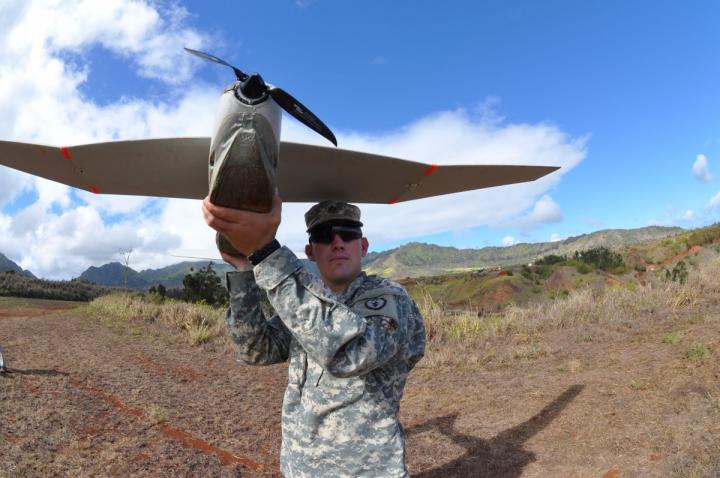
Credit: Sgt. Hillary Rustine
ABERDEEN PROVING GROUND, Md. — It’s no secret the U.S. Army wants its small unmanned aerial systems to operate quietly in densely-populated regions, but tests to achieve this can be expensive, time-consuming and labor-intensive according to researchers.
Miranda Costenoble, a graduate student researcher with the U.S. Army Combat Capabilities Development Command, now known as DEVCOM, Army Research Laboratory, presented work at the Vertical Flight Society’s 76th Annual Forum demonstrating how aviation experts can obtain information about airfoil boundary layers using computational fluid dynamics, or CFD, to enable the development of quieter air vehicles.
Smaller vehicles, like package delivery drones, for example, don’t typically fly as high as larger ones because they need to be able to land in virtually anyone’s front yard, she said. They also need to be quieter.
“Imagine a whole fleet of these delivery drones as loud; people aren’t going to want them in their neighborhoods,” Costenoble said. “So even though a small drone would produce less noise than a full-size rotorcraft in the first place just by virtue of being smaller and slower, there are more stringent requirements in terms of what’s expected from it.”
Researchers imagine any number of applications where the Army might like to deploy a small, stable, terrain-independent platform.
“Surveillance particularly gets talked about a lot as a sUAS application; however, if the adversary is aware that they’re being surveilled, they might shoot the sUAS down or hide from it,” she said.
If the sUAS sounds like 1,000 angry bees, then the adversary is going to notice it that much sooner and more easily, she said.
“So, this is a sound-sensitive application where the acoustic performance is going to be important to the overall design,” she said.
Costenoble, a doctoral candidate at University of Maryland College Park, works with other researchers on high-fidelity computational fluid dynamic codes, which small UAS designers can use to take acoustics into account just as easily as they would normally account for vehicle performance. This way, acoustics can be something, which is fundamental to sUAS design instead of being an afterthought, she said.
Costenoble is one of nine UMD students to earn Vertical Flight Foundation Scholarships this year.
It is not as simple as applying existing noise models for full-size rotorcraft to smaller ones, she said. Full-size rotorcraft, with large rotors moving at high speeds, operate in aerodynamic conditions where their acoustics are dominated by the sound of the rotor blades passing the observer; however, the smaller and slower rotors used on small UAS operate in a different aerodynamic regime, where acoustics are dominated by the noise created by the blades passing through and disturbing the air around them. Because this noise occurs across a range of medium and high frequencies, it is referred to as broadband noise.
“To take broadband noise into account during the small UAS design process, we use semi-empirical models,” she said. “Those models were developed over 30 years ago for a particular airfoil, and so may need to be updated to account for the physics of different airfoil shapes.”
Using these models requires some knowledge of the rotor blade airfoil’s boundary layer flow – that is, the airflow near the surface of the rotor blade’s airfoils – she said, since the disturbance of the air within the boundary layer is the source of the broadband noise.
“The parameters of the boundary layer flow are not available in prior literature for most airfoils, and cannot necessarily be obtained from simplified aerodynamics methods,” Costenoble said. “The goal of this work is to develop a method of obtaining the parameters of the airfoil boundary layer from an existing high-fidelity computational fluid dynamics code, without requiring any more effort from the code’s end-user than was required previously.”
The goal of her work is to develop a method of obtaining the parameters of the airfoil boundary layer from an existing high-fidelity computational fluid dynamics code, without requiring any more effort from the code’s end-user than was required previously, she said.
Without this methodology, researchers would obtain this kind of information from wind tunnel tests, “but those are expensive and time-consuming. It would also have been possible to use existing CFD codes, but would have required labor-intensive post-processing of the code’s output,” Costenoble said.
This project is part of a research program at the laboratory to address UAS platform design and control challenges. Researchers said they are looking for enabling capabilities to advance Army missions in the multi-domain operations.
“Interdependence of various research areas requires a comprehensive approach to develop solutions that improve a number of desired attributes in UAS’ such performance, maneuverability and noise simultaneously,” said Dr. Rajneesh Singh, lead for Vehicle Integrated Analysis at the laboratory.
Reducing noise emission without compromising on the UAS flight range or endurance has been “a hard problem for the S&T community,” Singh said, but this collaborative project gets the Army closer to addressing it.
Singh also credits ARL’s open campus business model, which allows the Army to expand the research network required for comprehensive approaches.
###
Researchers discuss this work in a paper, Computation and Extraction of Boundary Layer Parameters from Numerical Simulations for Use in Rotor Acoustics Models, representing collaborative work with the University of Maryland, College Park.
Visit the laboratory’s Media Center to discover more Army science and technology stories
DEVCOM Army Research Laboratory is an element of the U.S. Army Combat Capabilities Development Command. As the Army’s corporate research laboratory, ARL is operationalizing science to achieve transformational overmatch. Through collaboration across the command’s core technical competencies, DEVCOM leads in the discovery, development and delivery of the technology-based capabilities required to make Soldiers more successful at winning the nation’s wars and come home safely. DEVCOM is a major subordinate command of the Army Futures Command.
Media Contact
T’Jae Ellis
[email protected]
Original Source
https:/




